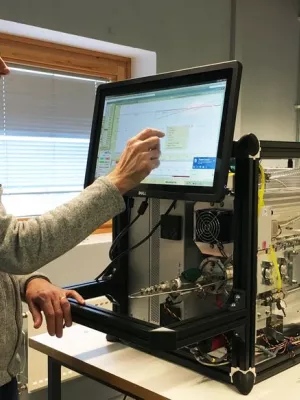
Erik Swietlicki
Professor

Primary and secondary biomass burning aerosols determined by proton nuclear magnetic resonance (H-1-NMR) spectroscopy during the 2008 EUCAARI campaign in the Po Valley (Italy)
Författare
Summary, in English
Atmospheric organic aerosols are generally classified as primary and secondary (POA and SOA) according to their formation processes. An actual separation, however, is challenging when the timescales of emission and gas-to-particle formation overlap. The presence of SOA formation in biomass burning plumes leads to scientific questions about whether the oxidized fraction of biomass burning aerosol is rather of secondary or primary origin, as some studies would suggest, and about the chemical compositions of oxidized biomass burning POA and SOA. In this study, we apply nuclear magnetic resonance (NMR) spectroscopy to investigate the functional group composition of fresh and aged biomass burning aerosols during an intensive field campaign in the Po Valley, Italy. The campaign was part of the EUCAARI project and was held at the rural station of San Pietro Capofiume in spring 2008. Factor analysis applied to the set of NMR spectra was used to apportion the wood burning contribution and other organic carbon (OC) source contributions, including aliphatic amines. Our NMR results, referred to the polar, water-soluble fraction of OC, show that fresh wood burning particles are composed of polyols and aromatic compounds, with a sharp resemblance to wood burning POA produced in wood stoves, while aged samples are clearly depleted of alcohols and are enriched in aliphatic acids with a smaller contribution of aromatic compounds. The comparison with biomass burning organic aerosols (BBOA) determined by high-resolution aerosol mass spectrometry (HR-TOF-AMS) at the site shows only a partial overlap between NMR BB-POA and AMS BBOA, which can be explained by either the inability of BBOA to capture all BB-POA composition, especially the alcohol fraction, or the fact that BBOA account for insoluble organic compounds unmeasured by the NMR. Therefore, an unambiguous composition for biomass burning POA could not be derived from this study, with NMR analysis indicating a higher O / C ratio compared to that measured for AMS BBOA. The comparison between the two techniques substantially improves when adding factors tracing possible contributions from biomass burning SOA, showing that the operational definitions of biomass burning organic aerosols are more consistent between techniques when including more factors tracing chemical classes over a range of oxidation levels. Overall, the non-fossil total carbon fraction was 50-57%, depending on the assumptions about the C-14 content of non-fossil carbon, and the fraction of organic carbon estimated to be oxidized organic aerosol (OOA) from HR-TOF-AMS measurements was 73-100% modern.
Avdelning/ar
- Kärnfysik
- MERGE: ModElling the Regional and Global Earth system
Publiceringsår
2014
Språk
Engelska
Sidor
5089-5110
Publikation/Tidskrift/Serie
Atmospheric Chemistry and Physics
Volym
14
Issue
10
Dokumenttyp
Artikel i tidskrift
Förlag
Copernicus GmbH
Ämne
- Subatomic Physics
Status
Published
ISBN/ISSN/Övrigt
- ISSN: 1680-7324